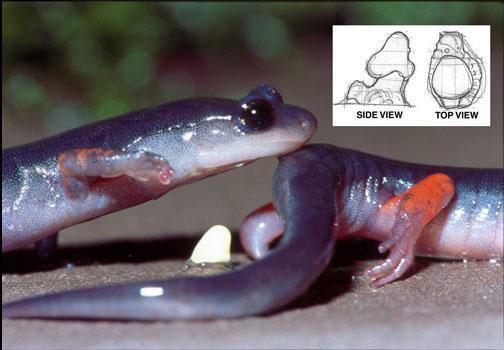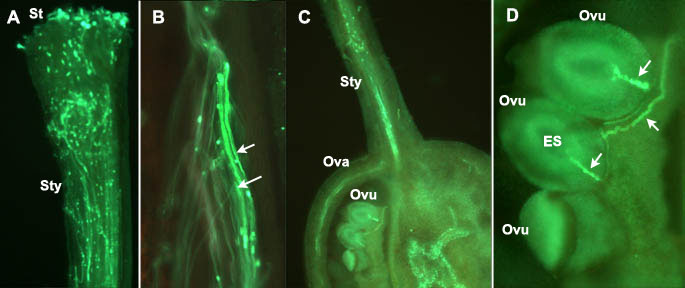General Biology II, lecture on Sexual Reproduction
XII. Sexual Reproduction:Vertebrates
A. Combination of male and female gametes
1. Ova with spermatozoa
B. Fertilization
1. External
a. usually happens in water
b. some gametes are lost
c. fishes & frogs (not all of either group)
d. plant pollen can be delivered by wind, water or insects
2. Internal
a. inside the female
b. requires intromission
i. except plant pollen produces a pollen tube
ii. except in salamanders and newts: spermatophore
iii. except birds: cloacal apposition
iv. intromittent organ
3. Intromittent organs
a. males, delivers sperm into the vagina
b. sharks - copulatory organ = claspers
i. derived from part of the pelvic fin
(not homologous to the penis)
ii. sperm conducted in a groove
c. teleost fishes - gonopodium
i. derived from anal fin
ii. grooved
d. frogs (fast moving streams)
- intromittent organ derived from tail tissue
e. hemipenis (half), hemipenes
i. some reptiles
ii. two
iii. homologous with penis
f. penis
i. derived from urogenital sinus tissue
ii. marsupials have 2
iii. hemotumescent
C. Male Reproductive Tract
1. Testes/Anthers
a. seminiferous tubules/sporangia (4)
i. spermatogenesis/2-3 celled pollen
b. Leydig cells/support system
i. inbetween tubules
ii. produce testosterone (T)
iii. plant stamen filament delivers nutrients
2. Epididymis
a. sperm storage
3. Vas Deferens
a. carries sperm
i. pollen tube
4. Seminal Vesicles, Prostate, Bulbourethral (Cowper's) gland
a. each secretes part of seminal fluid or semen
5. Urethra
a. carries semen and spermatozoa through penis
D. Female Reproductive Tract
1. Ovaries (2; Ovary singular)
a. Follicle
i. 2 layers of cells which surround each ovum
b. Ova/ovules
i. yolked in some animals, or surrounded by fluid
(1) ovules surrounded by fruit
ii. mammals (humans): all are made before birth
iii. other vertebrates (and mammals?):
made new during life from germinal bed
2. Fallopian Tubes (2)
a. fimbriated extremity (fingers)
i. become engorged with blood (hemotumescent) to
envelope the ovary and capture the egg
b. ostium (opening)
3. Uterus (womb)/Ovary in plants
a. horns - 2 sides for animals which have
more than one embryo or egg
b. some species (e.g. lizards) have two uteri
c. endometrium (lining)
i. zygote embeds here
d. myometrium (muscle)
4. Cervix
5. Vagina / Style with pollen tube
6. Vestibule of the Vagina / Stigma of the plant
a. greater and lesser vestibular glands
i. homologous to prostate, bulbourethreal, seminal vesicles
b. urethra
c. clitoris
b. labia minora
c. labia majora
E. Menstrual Cycle
1. Hypothalamus
a. GnRH = gonadotropin releasing-hormone
i. stimulates release of gonadotropins (LH + FSH)
b. site of negative feedback
c. site of positive feedback
2. Pituitary (hypophysis) to Ovary
a. FSH = follicle stimulating-hormone (gonadotropin)
i. stimulates follicles cells to grow
ii. FSH converts testosterone (T) to estrogen (E2)
in the inner layer of follicle cells
b. LH = luteinizing hormone (gonadotropin)
i. stimulates outer layer of follicles to begin making T
ii. stimulates ovulation (after ~ 14 days)
(1) E2 normally feeds back negatively
on the hypothalamus and lowers levels
of gonadotropins (FSH and LH)
(2) in a hypothalamic positive feedback center E2
feeds back positively (reaches threshold)
until a signal is sent to release GnRH,
which in turn causes a surge of LH
(3) LH causes the follicle to rupture and
the ovum is captured by the fimbriated
extremity of the fallopian tubes
iii. follicle cells become luteinized - a corpus luteum (CL)
(1) begin producing P (progesterone)
3. Fallopian tubes
a. fertilization will take place here
4. Uterus
a. fertilized egg has been dividing and producing
its own gonadotropin hCG
b. outer cell layers embed in the endometrium
c. the embryo surrounded by cells of the endometrium is
supported at first by P from the corpus luteum (CL)
d. if no fertilization or implantation, the CL and endometrial cells
of the uterus begin to make PGs (after 14 more days)
i. PGs kill the luteal cells ðò [P + E2]
ii. PGs squeeze off the blood supply to the endometrium
(1) the endometrial cells begin to die and slough off,
as they do they break off the capillaries that supplied
the endometrium, and some bleeding occurs
e. -feedback is reduced so gonadotropins increase followed
by a growth of follicles È E2 and + feedback
F. Pregnancy
1. If fertilization and implantation occur ® the cells of the
embryo and those of the mother form the placenta
a. placenta brings oxygen and nutrients
i. blood of mother and fetus never mix
b. placenta makes hormones
i. P
(1) supports the pregnancy
ii. hCG
iii. hCSomatomammotropin (hCS) or hPL
2. The Fetus' adrenal gland (+ liver + placenta) makes estrogen
(E3 = estriol) for the mother
a. converts P from the placenta
b. when the fetus begins to mature
the adrenal also matures and begins to produce cortisol
i. hormone (cortisol or androstenedione) from the fetus at the
time of adrenal maturation begins the process to initiate birth
3. At that time the placental P is converted to E2
4. The ovary makes more E2
a. and for the first time in 9 months there is
more estrogen than P
5. Oxytocin (OT) receptors increase on the uterine myometrium
and contractions begin
a. OT from the poster pituitary increase
in the blood, contractions increase
b. PGs are secreted by the uterus,
contractions increase
6. Epinephrine can block the contractions
7. Relaxin (which began to be produced somewhat earlier)
loosens cartilage
a. especially pubic symphysis
b. and cervix

